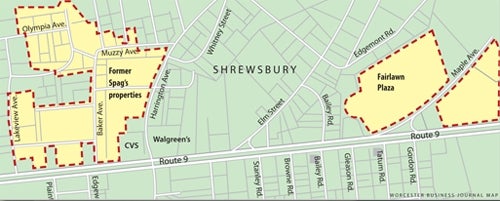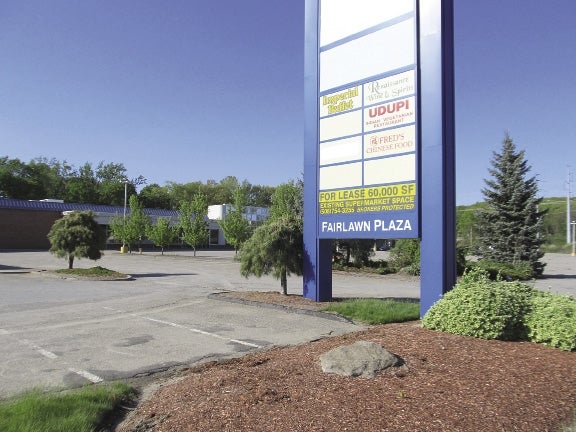Is revitalized retail on the way for Rte. 9 in Shrewsbury?
Jay Thomas remembers how things used to be along Shrewsbury's Route 9 retail district.
For nearly 45 years, Thomas Auto Parts could count on spillover business from Spag's, a mainstay at 193 Boston Tpk. for seven decades. The discount department store would send customers directly across the street if they didn't carry a particular auto part, which Thomas said accounted for a good portion of his clientele.
As Spag's business faltered though, the store was converted into a Building 19, which closed in 2013. (The site is being used today by dealers of antiques.) Today, Thomas said much of Route 9 east of the White City Shopping Plaza is dark and desolate.
“It's been awful,” said Thomas, who also chairs the Lakeway Business District Association. “If you drive down Route 9 at night, it's like a ghost town.”
But two developers hope to recapture the corridor's old magic through expansive mixed-use projects.
Southborough-based Grossman Development Group has proposed building 80,000 to 100,000 square feet of retail space, along with 250 apartments and 20 townhouse units at the 20-acre former Spag's site. The development would carry the name Lakewood Commons.
A little further east, Fairlawn Plaza sits mostly abandoned after Price Chopper moved its Shrewsbury supermarket three miles east in November 2010.
Worcester-based Plaza Properties LLC hopes to redevelop that — and the 27.8-acre former Spag's warehouse site across Maple Avenue — into 215,000 square feet of retail space, 186,000 square feet of office space, a 51,000-square-foot fitness area, 12,000 square feet of restaurant space and 19 single-family homes.
“People will have a reason to come back to where we are,” Thomas said.
Work may begin next year
Plaza Properties plans to break ground on what it calls The Grove Shrewsbury by early 2015 and finish construction within five years, according to an email from project developer Sam Adams.
Grossman said work on Lakeway Commons likely won't begin for at least a year since the project still needs to go through the permitting process. Construction, however, is expected to last no more than 18 months, company president Howard Grossman said.
The projects will also benefit from the completion of the Burns Bridge replacement in fall 2015, said Kristen Las, Shrewsbury's economic development coordinator. That project will improve traffic flow along Route 9 at the Shrewsbury-Worcester line by adding a third travel lane in each direction.
The Grove will anchor the east end of the town's Route 9 retail district, Las said, complementing the recently-renovated White City complex that's situated on the west end, next to Lake Quinsigamond.
“What they're doing is creating community where there are gaps,” said Karen O'Malley, a real estate lawyer with Boston-based Goulston & Storrs.
The redevelopment will also add money to the town's coffers. In the last year, the sites were fully occupied — 2002 and 2009, respectively — Spag's generated $127,400 in property tax revenue for the town, while Fairlawn Plaza yielded $75,600, according to Town Treasurer Carolyn Marcotte.
Most of Fairlawn Plaza was built in 1958, Adams's family purchased the 378 Maple Ave. site some 15 years later, and Sam Adams took control of the facility in the late 1990s. As the decades passed, Adams said the layout became antiquated, making it increasingly difficult to attract desirable tenants.
So, Adams has decided to raze the 88,000-square-foot strip mall and replace it on the same 8.8-acre footprint with 230,000 square feet of office and retail space. The increased density is expected to help draw workers and visitors from far and wide, he said.
Improving economy enabled Grossman plans
Unlike Adams, Grossman doesn't yet own the site on which he wishes to build. Positive economic trends prompted him to unveil his proposal in April for the former Spag's site.
O'Malley said three components set apart the most successful mixed-use developments: upscale supermarkets, strong restaurants and quality entertainment options such as a bowling alley or movie theater.
A grocery store is vital for filling up the development's residential units, O'Malley said, while the other amenities give outsiders a reason to visit. Retailers typically need business from non-residents to meet their sales goals, she said.
O'Malley said residences at mixed-use developments have attracted a surprising level of interest from families with young children, who often take in early dinners in the complex's restaurants. Developers can maximize their appeal to this demographic by offering two- and three-bedroom apartments rather than just studios and one-bedroom units, she said.
Target market: Empty nesters, young professionals
Grossman, however, plans to gear his apartments toward either young professionals working or studying at University of Massachusetts Medical Center, on the other side of the bridge, or empty-nesters looking to downsize but remain in the area. Adams declined to elaborate on the target demographic for his residential units, but the proposed single-family homes would likely suit larger households well.
Although not too many people actually live and work in the same development, O'Malley said providing office space keeps the development buzzing at all hours and avoids having it become a bedroom community with little activity during the day.
While office space has not been ruled out for Lakeway Commons, Grossman said his focus so far has been almost entirely on retail and residential offerings.
“We're not counting on it (office space) at all, nor do we need it,” he said.
White City's success
The two developments will compete against not only each other for retail tenants, but the 255,000-square-foot White City complex, which is enjoying high occupancy levels after a roughly $12.5 million facelift.
Adams said The Grove will differentiate itself by providing a broader scale of retail offerings than Lakeway Commons, along with superior access and less traffic than at White City.
Grossman said Lakeway Commons will excel at pedestrian friendliness through wide sidewalks and greenery. He also believes the density and employment base along Route 9 are sizable enough to support more than one mixed-use development.
“There's more room than it might appear for competition,” Grossman said.
Editor's Note: This story was updated at 12:05 p.m. Wednesday to clarify the duration of Samuel Adams's involvement with Fairlawn Plaza.













0 Comments